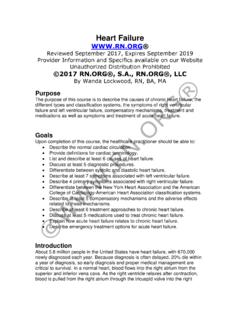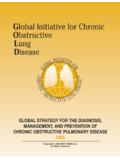Transcription of PULMONARY ASPIRATION OF GASTRIC CONTENTS …
1 Sign up to receive ATOTW weekly - email ASPIRATION OF GASTRIC CONTENTSANAESTHESIA TUTORIAL OF THE WEEK 192 16TH AUGUST 2010Dr Wendy King FRCASpR in AnaesthesiaPortsmouth Hospitals NHS TrustCorrespondence to Before continuing, try to answer the following questions regarding ASPIRATION during anaesthesia. The answers can be found at the end of the article, with or false? patients who suffer from gastro-oesophageal reflux are at greatest risk of emptying for all solids occurs within 6 pressure applied at 30 N compresses the oesophagus in 90% of antibiotic therapy is in those who develop symptoms is approximately 10%INTRODUCTION ASPIRATION was first recognised as a cause of an anaesthetic-related death in 1848 by James Simpson. Much later in 1946, Mendelson described the relationship between ASPIRATION of solid and liquid matter, and PULMONARY sequelae in obstetric patients.
2 Today it remains a rare but potentially devastating complication of general anaesthesia, quoted as occurring in between 1 in 3000 and 1 in 6000 anaesthetics. This increases to 1 in 600 for emergency anaesthesia in can be defined as the inhalation of material into the airway below the level of the true vocal cords. It is linked with a range of clinical outcomes, being asymptomatic in some instances and resulting in severe pneumonitis and ARDS in others. This tutorial will cover the pathophysiology and predisposing factors, and go on to discuss prevention and lower oesophageal sphincter (LOS) is functionally distinct from the oesophagus, and acts as a valve preventing the reflux of GASTRIC CONTENTS . Barrier pressure is the difference between LOS pressure (normally 20-30mmHg) and intragastric pressure (normally 5-10mmHg) and both are influenced by a number of factors.
3 LOS pressure is reduced by peristalsis, vomiting, during pregnancy (a progesterone effect) as well as pathological conditions such as achalasia, and various drugs (anticholinergics, propofol, thiopentone, opioids). Intragastric pressure is increased if the GASTRIC volume exceeds 1000ml, and with raised intra-abdominal pressure such as that occurring with pneumoperitoneum during laparoscopy. The resulting drop in barrier pressure may increase the risk of ASPIRATION , although it should be pointed out that studies have shown a concomitant increase in LOS pressure in anaesthetised patients undergoing laparoscopy, thus maintaining barrier 192 PULMONARY ASPIRATION of GASTRIC CONTENTS 16/08/2010 Page 1 of 6 Sign up to receive ATOTW weekly - email volume is influenced by the rate of GASTRIC secretions (approx ), swallowing of saliva (1ml/kg/hr), ingestion of solids/liquids, and the rate of GASTRIC emptying.
4 The rate of GASTRIC emptying for non-caloric clear fluids is rapid the half-time being about 12 minutes. Solids however, require six hours or more to be cleared from the stomach, displaying zero-order kinetics. Altered physiological states such as pregnancy, labour, abdominal pain, gastrointestinal orders, renal failure and diabetes will alter the rate of GASTRIC emptying, as well as drugs such as opioids. PREDISPOSING FACTORSAs suggested above, patients at greatest risk are those undergoing unplanned surgery, but also inadequate level of anaesthesia, those with abdominal pathology or the obese. Other examples are found below:Table 1: Predisposing factors for ASPIRATION under general anaesthesiaPatient factorsIncreased GASTRIC contentIntestinal obstructionNon-fastedDrugsDelayed GASTRIC emptyingLower oesophageal sphincter incompetenceHiatus herniaGastro-oesophageal refluxPregnancyMorbid obesityNeuromuscular diseaseDecreased laryngeal reflexesHead injuryBulbar palsyGenderMaleAgeElderlyOperation factorsProcedureEmergencyLaparoscopicPos itionLithotomyAnaesthetic factorsAirwayDifficult intubationGas insufflationMaintenanceInadequate depth CLASSIFICATIONA spiration pneumonitisKnown as Mendelson s syndrome, as described by the obstetrician in 1946, this condition involves lung tissue damage as a result of ASPIRATION of non-infective but very acidic GASTRIC fluid.
5 This usually occurs in two phases firstly desquamation of the bronchial epithelium causing increased alveolar permeability. This results in interstitial oedema, reduced compliance and VQ mismatch. The second stage, occurring within 2 to 3 hours, is due to an acute inflammatory response, mediated by proinflammatory cytokines such as tumour necrosis factor alpha and interleukin 8 and reactive oxygen products. Clinically, this may be asymptomatic, or present as tachypnoea, bronchospasm, wheeze, cyanosis and respiratory insufficiency. ASPIRATION pneumoniaThis occurs either as a result of inhaling infected material or secondary bacterial infection following chemical pneumonitis. It is associated with typical symptoms of pneumonia such as tachycardia, tachypnoea, cough and fever, and may be evidenced by segmental or lobar consolidation (classically right middle lobe) on chest radiography.
6 The disease process is similar to a community acquired pneumonia although the complication rate is higher, with cavitation and lung abscess occurring more 192 PULMONARY ASPIRATION of GASTRIC CONTENTS 16/08/2010 Page 2 of 6 Sign up to receive ATOTW weekly - email aspirationIf particulate matter is aspirated, acute obstruction of small airways will lead to distal atelectasis. If large airways are obstructed, immediate arterial hypoxaemia may be rapidly fatal. PREVENTIONP reoperative fasting The commonly quoted figures of a critical volume of 25ml of aspirate, with a pH < being sufficient to cause ASPIRATION pneumonitis are derived from unpublished work by Roberts and Shirely on Rhesus monkeys, and extrapolated to humans. In fact 50% of fasted patients have a residual GASTRIC volume exceeding this, with an average pH of around Unnecessarily prolonged nil by mouth (NBM) orders lead to dehydration and possibly hypoglycaemia, with resultant thirst, hunger, discomfort and irritability.
7 Current guidelines are 2 hours for clear fluids, 4 hours for breast milk, and 6 hours for a light meal, sweets, milk (including formula) and non clear fluids. Reducing GASTRIC acidityHistamine (H2) antagonists and proton pump inhibitors (PPIs) are commonly used to increase GASTRIC pH, although they do not affect the pH of fluid already in the stomach. Oral sodium citrate solution reliably elevates GASTRIC pH above , but it increases GASTRIC volume, and is associated with nausea and vomiting. H2 antagonists act by blocking H2 receptors of GASTRIC parietal cells, thereby inhibiting the stimulatory effects of histamine on GASTRIC acid secretion. PPIs on the other hand, block the proton pump of the same cell, inhibiting the stimulatory actions of histamine, gastrin and acetylcholine.
8 An oral H2 antagonist must be given 1-2 hours before anaesthesia, and a PPI, 12 hours in advance. A recent meta-analysis by Clark et al suggested that ranitidine was superior to PPIs in both reducing GASTRIC fluid volume and acidity. Its use is recommended in patients at risk of ASPIRATION only, not routinely. Metoclopramide has a prokinetic effect promoting GASTRIC emptying, but there is little evidence to support its use. It does however, remain part of the usual pre-medication for Caesarean section under general Sequence Induction (RSI)It has been shown that most cases of ASPIRATION occur on induction and laryngoscopy, hence the following is of the utmost importance. For patients at high risk of ASPIRATION , a RSI is the induction of choice unless presented with a sufficiently difficult airway to warrant an awake fibreoptic intubation.
9 The patient should be on a tilting trolley, with suction to hand. Three minutes of pre-oxygenation precede the administration of an induction agent, cricoid pressure (discussed below) and the rapidly acting muscle relaxant succinylcholine. This avoids the need for bag-mask ventilation and the possibility of GASTRIC insufflation. Adequate depth of anaesthesia is important to avoid coughing, laryngospasm and vomiting. Cricoid pressure is not released until confirmation of appropriate placement of the tracheal tube with the cuff inflated. Cricoid pressureFirst described by Sellick in 1961, cricoid pressure remains an essential manoeuvre performed as part of RSI despite significant controversy. The aim is to compress the oesophagus between the cricoid ring cartilage and the sixth cervical vertebral body thus preventing reflux of GASTRIC CONTENTS .
10 The force recommended is 30N, or that required to close the oesophagus without distorting the airway. This latter complication is the greatest limiting feature of the manoeuvre, causing malalignment, distortion of the cricoid ring and possible closure of the vocal cords. Even when applied correctly there is doubt as to its efficacy, simply causing anatomical displacement of the oesophagus in some people, and non compression in others. In addition, manometry studies have shown it to reduce LOS tone thus reducing barrier pressure. Cricoid pressure should be released in the case of active vomiting to avoid oesophageal rupture. Nasogastric tube placementPatients for emergency theatre with intestinal obstruction frequently have a nasogastric tube in situ. There is evidence from cadaver studies that this does not alter the efficacy of cricoid pressure.
















